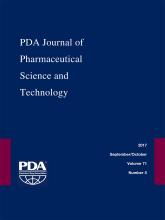Research ArticleTechnology/Application
Particulate Generation Mechanisms during Bulk Filling and Mitigation via New Glass Vial
Christopher L. Timmons, Chi Yuen Liu and Stefan Merkle
PDA Journal of Pharmaceutical Science and Technology September 2017, 71 (5) 379-392; DOI: https://doi.org/10.5731/pdajpst.2017.007724
Christopher L. Timmons
1Corning Incorporated, Corning, NY and
Chi Yuen Liu
2Janssen AG, Schaffhausen, Switzerland
Stefan Merkle
2Janssen AG, Schaffhausen, Switzerland

Reference
- 1.↵
- Langille S.
- 2.↵
- Tawde S.
- 3.↵
- Langille S.
- 4.↵
- Bukofzer S.,
- Ayres J.,
- Chavez A.,
- Devera M.,
- Miller J.,
- Ross D.,
- Shabushnig J.,
- Vargo S.,
- Watson H.,
- Watson R.
- 5.↵
- Gould C.
- 6.↵
- 7.↵
- Walpot H.,
- Franke R. P.,
- Burchard W. G.,
- Agternkamp C.,
- Müller F. G.,
- Mittermayer C.,
- Kalff G.
- 8.↵
- Zabir A.,
- Choy C. Y.,
- Rushdan R.
- 9.↵
- Lehr H.,
- Brunner J.,
- Rangoonwala R.,
- Kirkpatrick C. J.
- 10.↵
- 11.↵
- Falchuk K. H.,
- Peterson L.,
- McNeil B. J.
- 12.↵
- Shabushnig J.,
- Melchore J. A.,
- Geiger M.,
- Chrai S.,
- Gerger M. E.
- 13.↵
- Aldrich S.
- 14.↵Guidance for Industry: Sterile Drug Products Produced by Aseptic Processing—Current Good Manufacturing Practice, USDHHS, FDA, CDER, CBER, ORA, September 2004.
- 15.↵
- Woodcock J.
- 16.↵
- Le Houerou V.,
- Sangleboeuf J. C.,
- Dériano S.,
- Rouxel T.,
- Duisit G.
- 17.↵
- Lawn B.,
- Wiederhorn S. M.,
- Roberts D. E.
- 18.↵
- 19.↵
- Lawn B. R.,
- Wiederhorn S. M.,
- Johnson H. H.
- 20.↵
- Grigoriev I. S.
- 21.↵
- Wong J. Y.
- 22.↵
- Schaut R.,
- Peanasky J. S.,
- DeMartino S. E.,
- Schiefelbein S. L.
- 23.↵Guidance for Industry: Q9 Quality Risk Management, USDHHS, FDA, CDER, CBER, September 2006.
In This Issue
PDA Journal of Pharmaceutical Science and Technology
Vol. 71, Issue 5
September/October 2017
Particulate Generation Mechanisms during Bulk Filling and Mitigation via New Glass Vial
Christopher L. Timmons, Chi Yuen Liu, Stefan Merkle
PDA Journal of Pharmaceutical Science and Technology Sep 2017, 71 (5) 379-392; DOI: 10.5731/pdajpst.2017.007724
Jump to section
- Article
- Abstract
- Introduction
- Filling Line and Vial Damage Characterization
- Glass Particles on the Filling Line Results from Multiple Mechanisms
- Lab Evaluation of Particle Generation from Each Damage Mechanism
- New Vial Designed To Address Root Cause of Particulate Mechanisms
- Line Trials Using the New Vial Demonstrate Substantial Reduction in Particle Risk
- Conclusions
- Conflict of Interest Declaration
- Acknowledgments
- Reference
- Figures & Data
- References
- Info & Metrics
Related Articles
- No related articles found.
Cited By...
- Identification and Root Cause Analysis of the Visible Particles Commonly Encountered in the Biopharmaceutical Industry
- Risk Mitigation of Drug Shortages--A New Concept for Vials Designed to Improve Fill and Finish Performance
- Enhancing Patient Safety through the Use of a Pharmaceutical Glass Designed To Prevent Cracked Containers





